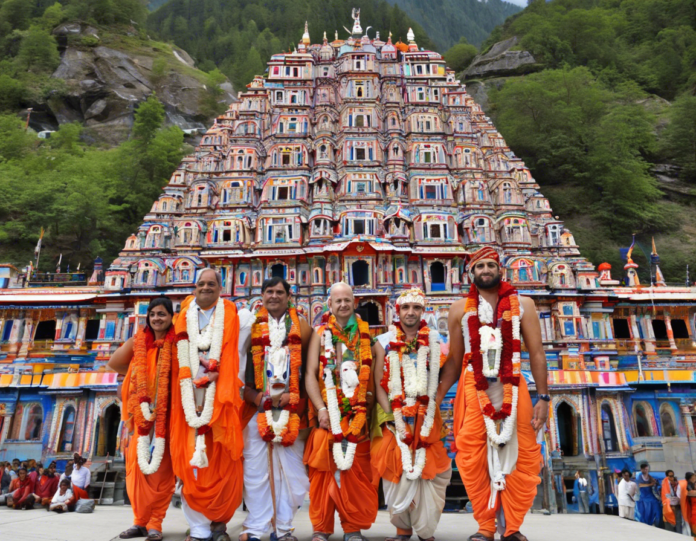Embarking on a spiritual journey can be a life-changing experience, especially when it involves visiting sacred sites deeply rooted in ancient traditions and beliefs. One such journey that holds immense significance in Hinduism is the 4 Dham Yatra, which comprises four important pilgrimage sites located in the Indian state of Uttarakhand and Uttar Pradesh. The 4 Dham Yatra is believed to cleanse the soul, purify the mind, and bring devotees closer to the divine.
The Four Dhams of the Yatra
The 4 Dham Yatra consists of four sacred shrines that are dedicated to different forms of the divine:
-
Yamunotri: The journey typically begins with a visit to Yamunotri, the source of the Yamuna River. The temple here is dedicated to Goddess Yamuna, who is believed to be the daughter of the Sun God, Surya. The hot water springs near the temple, known as Surya Kund, hold great significance for devotees.
-
Gangotri: The next stop on the yatra is Gangotri, the source of the Ganga River. This shrine is dedicated to Goddess Ganga, the epitome of purity and benevolence. It is believed that a visit to Gangotri washes away sins and brings liberation from the cycle of birth and death.
-
Kedarnath: Kedarnath is where devotees pay homage to Lord Shiva in the form of a lingam (a symbol of the god). Located amidst the Garhwal Himalayas, the Kedarnath Temple is one of the twelve Jyotirlingas and holds immense spiritual significance for Hindus.
-
Badrinath: The final destination of the 4 Dham Yatra is Badrinath, where Lord Vishnu is worshipped in the form of Lord Badri Narayan. Situated along the banks of the Alaknanda River, the Badrinath Temple is believed to be one of the holiest shrines in Hinduism.
The Spiritual Significance
The 4 Dham Yatra is not just a physical journey from one shrine to another; it is a profound spiritual undertaking that is believed to have numerous benefits for the pilgrim:
- Purification of the Soul: The yatra is thought to cleanse the soul of past sins and negative karma, allowing the pilgrim to start afresh on their spiritual journey.
- Seeking Blessings: Each of the four dhams is associated with a different deity, and by visiting all four, devotees seek the blessings and grace of these divine beings.
- Self-Reflection: The long and arduous journey through the rugged terrain of the Himalayas provides ample opportunities for self-reflection and introspection.
- Community and Camaraderie: The yatra often brings people from different walks of life together, fostering a sense of community and camaraderie among the pilgrims.
Preparing for the 4 Dham Yatra
Embarking on the 4 Dham Yatra requires careful planning and preparation to ensure a smooth and fulfilling experience:
- Physical Fitness: The yatra involves long treks at high altitudes, so it is essential to be in good physical health. Regular exercise and breathing techniques can help prepare the body for the journey.
- Packing Essentials: Since the shrines are located in remote areas, it is crucial to pack essentials such as warm clothing, sturdy footwear, first-aid kit, and personal hygiene items.
- Permits and Passes: Some areas along the yatra route may require permits for entry. It is advisable to obtain these in advance to avoid any last-minute hassles.
- Travel Arrangements: Whether you choose to travel by road or helicopter, it is essential to make all travel arrangements well in advance to ensure a hassle-free journey.
The Inner Journey
While the 4 Dham Yatra involves visiting external sacred sites, it is equally about embarking on an inner journey of self-discovery and spiritual growth:
- Meditation and Reflection: Take time during the yatra to meditate, reflect, and connect with your inner self. The serene surroundings of the Himalayas provide the perfect atmosphere for introspection.
- Prayer and Rituals: Participate in the prayers and rituals conducted at each of the shrines to deepen your spiritual experience and connect with the divine.
- Satsang and Discourse: Engage in satsangs (spiritual gatherings) and discourses with fellow pilgrims or spiritual leaders to gain insights and knowledge about the significance of the yatra.
Frequently Asked Questions (FAQs)
- Is the 4 Dham Yatra only for Hindus?
-
While the 4 Dham Yatra holds immense significance for Hindus, people from all faiths and backgrounds are welcome to undertake the journey with an open mind and reverence for the sacred sites.
-
What is the best time to undertake the 4 Dham Yatra?
-
The ideal time for the yatra is during the summer months of May to June and the autumn months of September to October when the weather is pleasant and the sites are accessible.
-
Are there any age restrictions for the 4 Dham Yatra?
-
There are no specific age restrictions for the yatra, but due to the physical demands of trekking at high altitudes, it is advisable to consult with a healthcare provider before embarking on the journey, especially for elderly individuals and children.
-
How long does the 4 Dham Yatra typically take to complete?
-
The entire yatra can take anywhere from 10 to 15 days, depending on the mode of transportation, the time spent at each shrine, and any additional stops along the way.
-
What are some common rituals performed during the 4 Dham Yatra?
-
Devotees often perform rituals such as offering prayers, taking a dip in the holy rivers, offering donations to the temples, and seeking blessings from the priests at each shrine.
-
Can the 4 Dham Yatra be undertaken solo or is it better to go with a group?
-
While it is possible to undertake the yatra solo, many pilgrims prefer to travel in groups for safety, companionship, and the opportunity to engage in spiritual discussions with fellow travelers.
-
What are some of the challenges faced during the 4 Dham Yatra?
-
Challenges such as altitude sickness, unpredictable weather, rough terrain, and limited facilities in remote areas can be encountered during the yatra. It is essential to be prepared for such eventualities.
-
Is photography allowed during the 4 Dham Yatra?
-
While photography is generally allowed at most sites, it is important to respect the sanctity of the shrines and seek permission before taking pictures of any rituals or ceremonies.
-
Are there any accommodation options available along the 4 Dham Yatra route?
-
There are various accommodation options ranging from guesthouses to dharamshalas (pilgrim shelters) available at each of the four dhams to cater to the needs of pilgrims.
-
What is the significance of completing the 4 Dham Yatra?
- Completing the 4 Dham Yatra is believed to bestow spiritual blessings, cleanse the soul, and pave the way for spiritual enlightenment and self-realization.
The 4 Dham Yatra is not just a physical journey; it is a profound spiritual quest that challenges the body, mind, and soul. By embarking on this sacred pilgrimage, devotees seek to purify themselves, seek the blessings of the divine, and deepen their connection to the spiritual realm. It is a transformative experience that leaves a lasting impact on the hearts and minds of those who undertake this sacred journey.


Recent comments